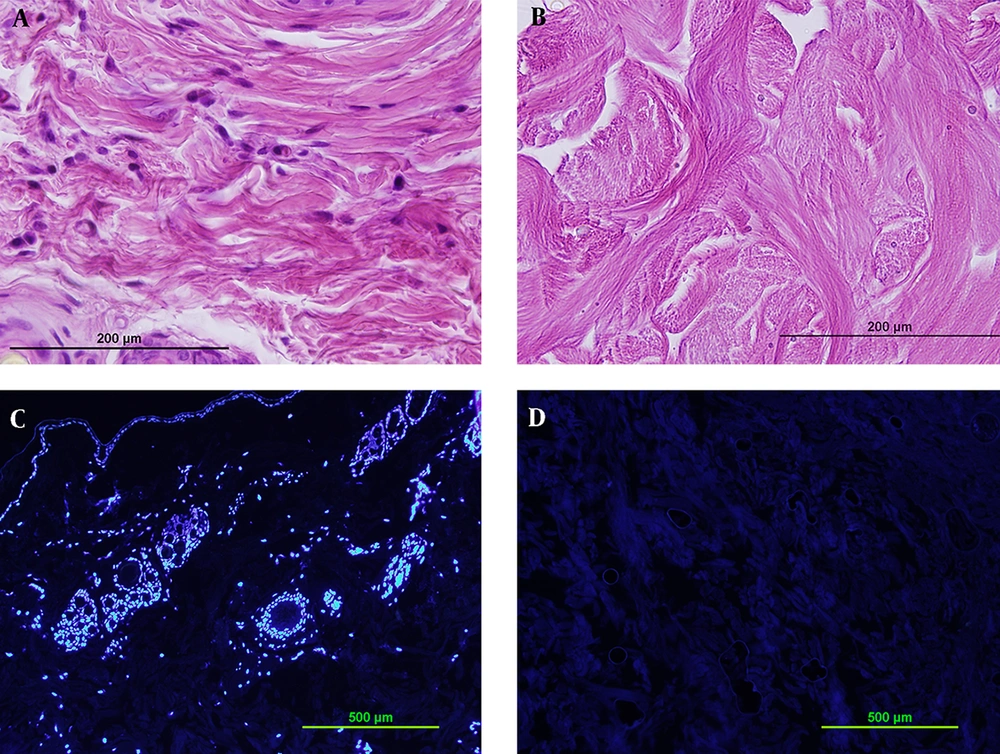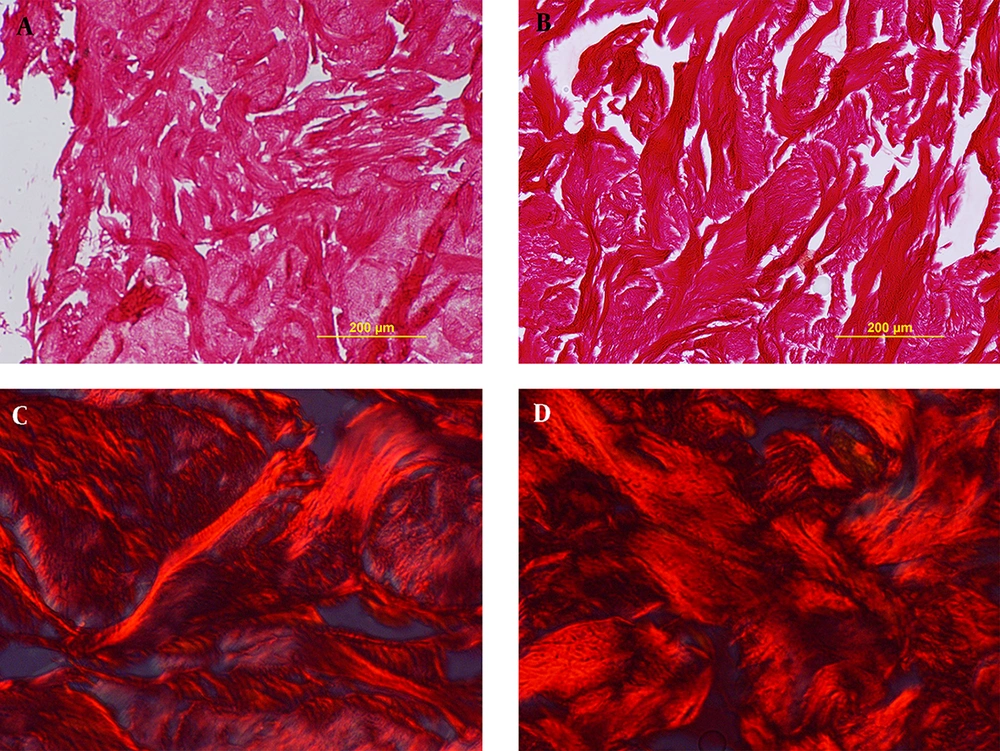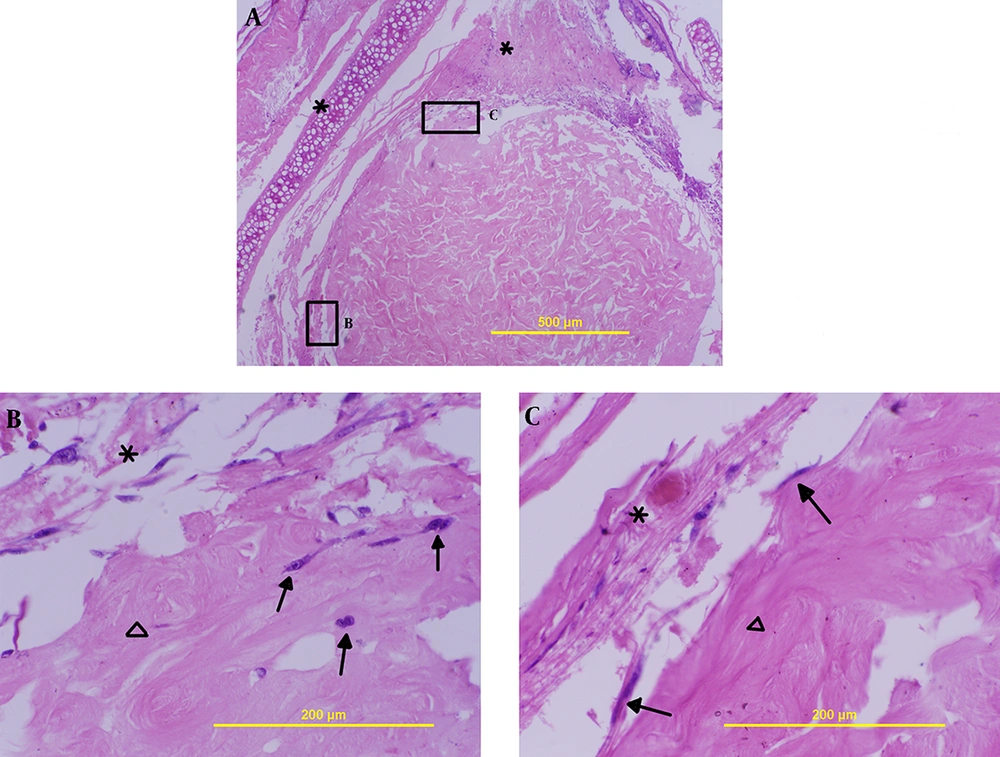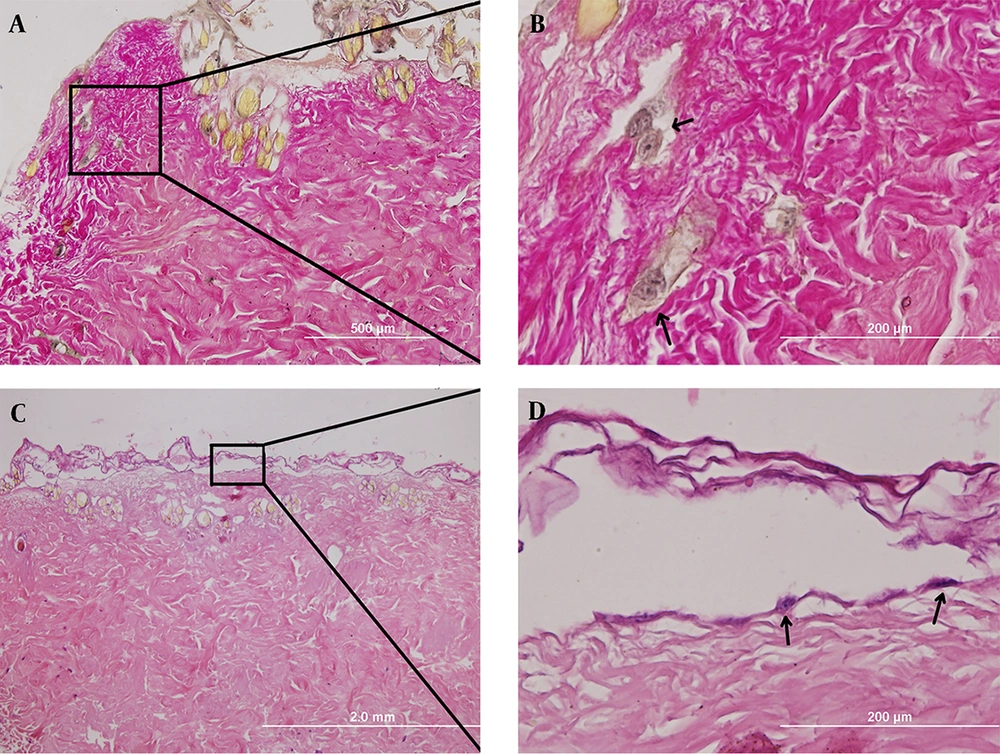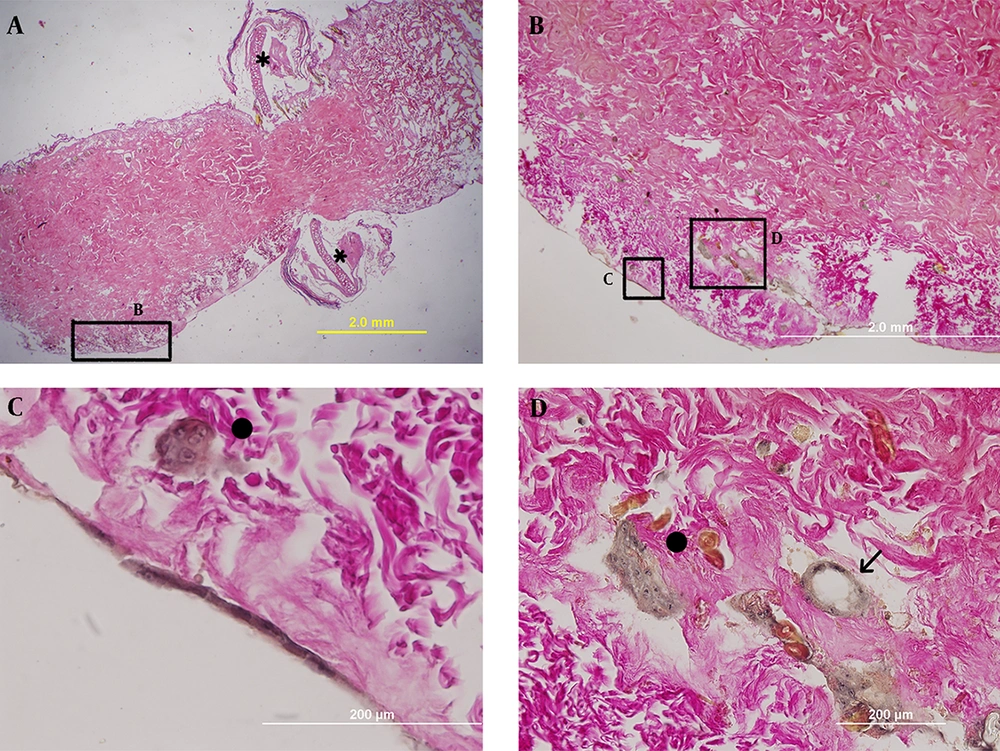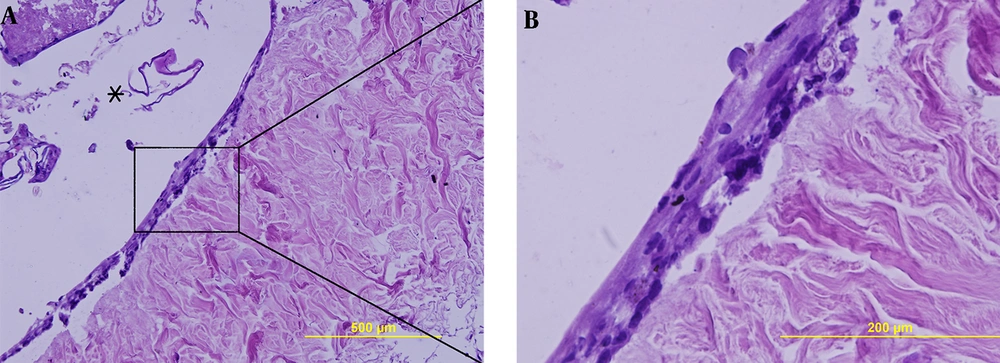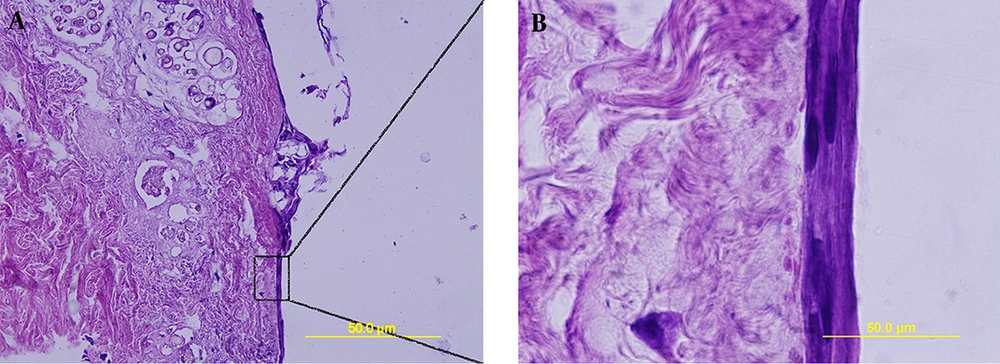1. Background
Extracellular matrix (ECM) is a complex, dynamic and critical constituent of all tissues. It performs as a scaffold for tissue morphogenesis, provides cues for cell proliferation and differentiation, raises the maintenance of differentiated tissue and increases the repair after injury (1).
One approach to design exogenous ECMs for tissue engineering is to mimic the function of ECM molecules naturally found in tissue. These native ECMs act as a scaffold to gather cells in a tissue, control the tissue structure and regulate the cell phenotype (2).
Elimination of cells from a tissue or an organ leaves the complex mixture of structural and functional proteins that constitute the ECM (3). Biologic scaffold derived from decellularized tissues and organs are successfully applied in both pre-clinical animal studies and in human clinical uses (4, 5).
To study cell behaviors in a 3-dimensional matrix, in addition to the use acellular dermal matrix (ADM) as a scaffold, the type of cell source is required. In previous cell behavior studies on ADM, different kinds of cells such as keratinocytes (6), adipose derived stem cells (7, 8) and fibroblasts (9, 10) were utilized. In the current study, blastema tissue from pinna of New Zealand White rabbit was used as a cell source. Rabbit blastema tissue is a collection of undifferentiated cells with embryonic-like properties that can regenerate damaged tissues pinnas and are able to convert to different cell types presented before injury (11). Such tissues are accessible 2 days after puncture of the New Zealand White rabbit pinnas (12).
2. Objectives
The current study aimed to verify whether acellular dermal matrix (ADM) is a suitable 3D-matrix for blastema tissue cells originated from pinna of rabbit and study different behaviors of these cells on ADM.
3. Materials and Methods
Six-month-old male New Zealand white rabbits (Oryctolagus cuniculus) purchased from Razi vaccine and serum research institute (RVSRI, Mashhad Iran) were used to obtain both ADM and blastema tissue. Animal experiments were performed according to the Iranian council for the use and care of animals guidelines approved by the animal research ethical committee of Ferdowsi university of Mashhad, Mashhad, Iran.
3.1. Preparation of the ADM Scaffolds
3.1.1. Decellularization Process
An autopsy performed on rabbit’s skin samples; in this pursuit, primarily the rabbit’s furs were removed, and the skin was isolated from the underlying muscle. In this study, various physical and chemical methods were utilized for cellular skin isolation. The physical method was slow freezing at - 4°C, and snap freeze-thaw in liquid nitrogen. The chemical method was utilizing sodium dodecyl sulfate (SDS) as a detergent (3).
For slow freezing, samples were incubated for one week in normal saline and stored at -4°C. By removing the samples from freezer, they were allocated into small pieces, and placed in 2 mL cryotubes to perform snap freezing in liquid nitrogen for two minutes. Subsequently, during the rapid melting phase, the cryotubes were placed within the buccal containing running water. Afterwards, the samples were removed from the cryotubes and washed with phosphate buffered saline (PBS). The snap freezing and thawing phases were repeated five times.
The chemical procedures were done after doing the snap freezing and thawing processes, to achieve the best method for complete elimination of cell nuclei, while preserving the ECM components, various percentages of SDS in different time periods were examined.
3.1.2. Sterilization of the ADM Scaffolds for Culture
To eliminate the remained detergents and minimize potential contamination, decellularized scaffolds were placed primarily inside plates containing 70% ethanol for 30 minutes; after washing with distilled water, they were placed in sterile PBS plates for an hour (13).
3.2. Preparation of Blastema Rings
To prepare the blastema rings, after removing the dorsal and ventral surface hair on the rabbit’s ears, and inducing local anesthesia, 2-mm-diameter holes were punched on the rabbits ears. Punch areas were selected between the medial ear artery and the marginal ear veins where no major vessels were present; 48 hours after creating the first hole, another hole with 4 mm diameter was created around the first hole. It was during this phase that the blastema ring was removed (12). Sterilizing the rings was done with sterile normal saline in seven steps. Before transferring the samples under the laminar hood, the scaffolds were assembled into the blastema ring, and inserted into the Dulbecco modified eagle’s medium (DMEM) supplemented with 15% fetal bovine serum (FBS) and 100 µL penicillin/streptomycin. Specimens were incubated in a humidified atmosphere to confirm complete cellular removal and also attain the structure of the scaffold by selective decellularization, various tissue staining methods were utilized. Investigations on skin samples before and after decellularization were done via fluorescent 4’, 6-Diamidino-2-phenylindole (DAPI) staining techniques, which demonstrated complete removal of the nuclear material from the decellularized scaffolds.
To check the density of the existing collagens in the extracellular matrix of the dermis, picrosirius red staining method was employed and specimens were studied via the light microscope and also the polarizing microscope.
4. Results
Using snap freeze thaw in liquid nitrogen as a physical method and treatment with 0.1 % SDS for 48 hours as a chemical method, resulted in the best elimination of cells while preserving the dermis structure. Complete decellularization was proved by hematoxylin and eosin (H & E) staining (Figure 1A, B) and DAPI fluorescent dye (Figure 1C, D).
Decellularized samples were stained via picrosirus red staining; after studying the specimen by light microscope and also polarizing microscope, no significant difference was observed in the amount of collagen fibers, as depicted in the Figure 2A - D.
On the fifth day after culture, a few cells, as illustrated in Figure 3B, migrated into the scaffold, and some of them were located at the edge area of the dermal scaffold (Figure 3C).
Ten days after culturing, cellular penetration continued into the scaffold (Figure 4A, B) as well as forming a separated, non-continuous cell layer located on the surface of ADM (Figure 4C, D ).
On the 15th day post culture, in addition to penetrating into the scaffold similar to the 5th day, some cells formed a continuous epidermal-like structure (Figure 5C) and some unrushed to the farthest marginal scaffold areas away from the blastema tissue (Figure 5C). The cells in these areas were located as a cell cluster (Figure 5C, D) or individuals. In addition to that, some sections formed a structure similar to blood vessels cross sections in which the cells gathered to form a circle (Figure 5D).
The remarkable points on the 20th day after implantation were the embarkation of multi-layered cell layer on the surface of the scaffold and an epidermis-like structure being created (Figure 6).
All events on the 25th day were similar to those of the 20th day; however, the cells became more stretched and fusiform (Figure 7).
Interaction between blastema tissue and ADM on the 5th day (H&E staining); A) (100x) shows position of blastema ring around ADM, B) a few cells penetrated into the scaffold 400x, C) cells located superficially on the ADM 400; the stars indicate blastema rings, triangle shows ADM and arrows present cells.
The 15th day post culturing; A) the blastema ring position toward the ADM (longitudinal section, 40x), B) blastema tissue cells formed structures at farthest area away from the blastema ring (100x), C) continuous single cell layer located on the surface of ADM (400x), D) migrated cells created blood vessel-like structure (presented by arrow sign) in addition to forming cell colonies (indicated by filled circle). The star sign shows blastema ring.
5. Discussion
The current study was designed to verify whether acellular dermal matrix is a suitable 3D-matrix for blastema tissue cells originated from pinna of rabbit and study different behaviors of these cells on ADM. The results of the in vitro blastema tissue- ADM interactions revealed various behaviors by blastema tissue cells on different days of culture. These cells first migrated to the ADM on the day five. Some migrated cells penetrated into the scaffold and some of them were located on the surface of ADM. Most migration and penetration by blastema tissue cells occurred on day 15. Penetrated cells created various structures such as blood vessel-like structures and different cell masses. On the other hand, on day 10 superficial cells formed a continuous cell layer which became multilayered on day 20.
5.1. Blastema Tissue Cell Migration
Migration of cells started since the fifth day after culturing. ADM may function as a scaffold for host cells, and as a biologically compatible framework into which epithelial cells and fibroblasts can adhere, migrate, repopulate and help the incorporation of the material into the newly formed tissue (5).
Fibronectins are essential for migration and differentiation of many cell types in embryogenesis (14). Fibronectins induce migration of cultured fibroblast (15). Schor suggests that the differences in the migratory behavior of Hela cells on various substrata in medium containing the same measure of fibronectin may be due to the preferential binding of fibronectin to collagen and the subsequent migration of the cells on the fibronectin-collagen complex (16). Considering that the dermal matrix is mainly composed of collagen, migration of blastema tissue cells would be expected.
5.2. Creation of Epidermal Like Structure
Placement of fibroblast cells as a superficial cell layer is also confirmed in other experiments (6, 17, 18). Maia claims that gingival fibroblasts and highly proliferative cells as B16F10 can only be superficially located on ADM (18). On the other hand, cell penetration into the scaffolds with high density of collagen is less than those of the ones with low density (19). Rodrigues suggests that ADM prepare good condition for seeded fibroblasts to adhere and spread on the matrix but migration into the matrix is low and cells penetrate into the scaffold through marginal zones or areas with low density of collagen (17). The placement of cells on the surface of the scaffold is probably due to the dense structure of the matrix, therefore this high density restricts the migration of cells into the scaffold and as a result, cells spread more on the surface. Cells observed in ADM penetrated more from marginal areas or areas with low density of collagen. Epidermal-like structure around ADM became multi-layered in the current study, unlike the results of gingival fibroblasts cultured on the scaffold, it may be probably caused by the different abilities of blastema tissue cells and fibroblasts.
5.3. Formation of Blood Vessel-Like Structure
Emergence of blood vessel-like structures was another astonishing event occurred on the 15th day. It is believed that during decellularization of mammal’s tissue, a natural three-dimensional structure is created in which the fine networks of blood vessels are preserved; therefore, after the occupation of scaffolding by new cells, vessel formation will happen faster (20). Laminin is also among the molecules creating effective vessel structures (1). Therefore, it can probably be said that in the dermal scaffold, the structure of vascular channels is somehow preserved and laminin extant in the vascular basement membrane is the reason for attracting cells to this area.
